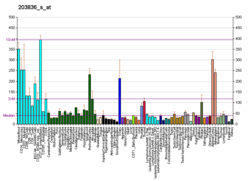Apoptosis signal-regulating kinase 1 (ASK1) also known as mitogen-activated protein kinase kinase kinase 5 (MAP3K5) is a member of MAP kinase family and as such a part of mitogen-activated protein kinase pathway. It activates c-Jun N-terminal kinase (JNK) and p38 mitogen-activated protein kinases in a Raf-independent fashion in response to an array of stresses such as oxidative stress, endoplasmic reticulum stress and calcium influx. ASK1 has been found to be involved in cancer, diabetes, rheumatoid arthritis, cardiovascular and neurodegenerative diseases. [5] [6]
Contents
MAP3K5 gene coding for the protein is located on chromosome 6 at locus 6q22.33. [7] and the transcribed protein contains 1,374 amino acids with 11 kinase subdomains.[ citation needed ] Northern blot analysis shows that MAP3K5 transcript is abundant in human heart and pancreas. [8]







